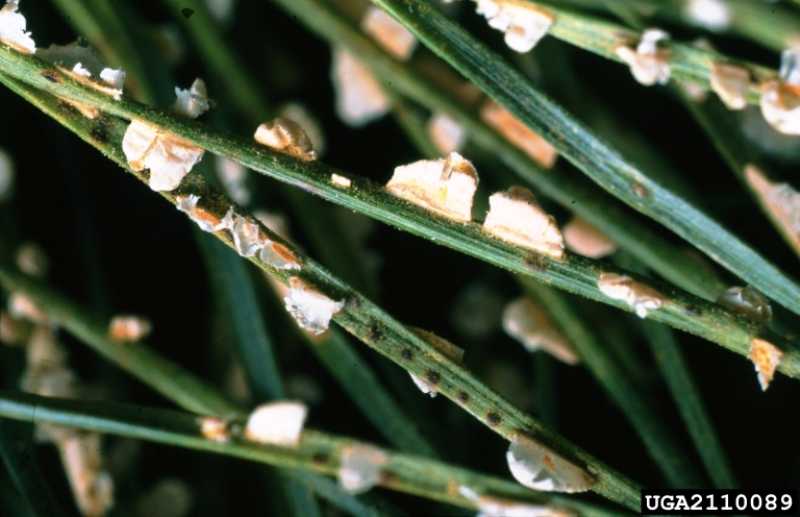Introduction
Pine needle rust is a fungal disease that affects many species of pine. The disease is caused by over twenty species of Coleosporium fungi. Coleosporium asterum is the most commonly identified. The fungi require two host plants to complete their life cycle: a pine tree, and a plant from the aster (Asteraceae) family. Pine needle rust discolors needles. Severe infections can disfigure needles on pines, and inhibit tree growth.
Distribution & Habitat
Pine needle rust occurs on susceptible pine trees throughout the United States.
Hosts
Pine needle rust infects pine trees, and members of the aster family. Pine trees that are often infected include Austrian pine, Jack pine, red pine, ponderosa pine, mugo pine, and Scots pine. Plants in the aster family that are frequently infected include aster and goldenrod. Infections have also been reported on daisy fleabane, gumweed, and goldenaster, albeit with less frequency.
Disease Cycle
The needle rust fungi create multiple types of spores that contribute to the disease cycle. The spores enable the disease to alternate between pine trees, and plants in the aster family. All of the different spore types require moisture on leaves and needles to initiate new infections. The needle rust fungi overwinter within living plant tissue. They reside within pine needles, and leaves of Asteraceae plants. On the infected needles and leaves, yellow to orange fruiting structures give rise to white tube-like spore producing structures. When conditions are favorable, the white spore-producing structures rupture, and release powdery orange spores, which are disseminated by air currents to the leaves of susceptible plants in the aster family. The spores produced on pine needles are incapable of infecting other pine needles. Infected leaves of Asteraceae plants produce yellow-orange spores on the lower leaf surfaces throughout the growing season. These orange spores can only infect another member of the aster family. In fall, a dark brown spore type is formed on the leaves of infected Asteraceae plants, which is carried by the wind to infect nearby pine needles.
Symptoms of Infection on Pine Trees
Yellow to orange spots or bands appear on the infected needles in spring. The needles brighten, turning partly or entirely yellow. From late spring to early summer, minute raised white tubes form on the needles, and rupture, expelling powdery, orange spores into the air. Infected needles may remain attached to the tree for several years. Severe infections often cause the needles to brown, and fall prematurely. The lower branches of young trees are the most affected.
Symptoms of Infection on Asteraceae Plants
Infected leaves develop yellow spots on the upper leaf surface, and raised orange pustules on the lower leaf surface. The orange pustules produce yellow-orange spores on the lower leaf surface throughout the growing season. Dark brown spores appear within leaf spots on the lower leaf surface from summer to fall.
Management
- Pine needle rust is considered a minor stress on mature trees. As such, management is not often required.
- Maintain tree vigor through sound cultural practices. Ensure that trees are sufficiently watered, especially during extended periods of drought. Apply a layer of organic mulch around the base of susceptible trees to improve soil quality, moderate soil temperature, and retain soil moisture.
- Remove alternative hosts, such as aster, goldenrod, and other members of the aster family. This will reduce the incidence of infection on pine trees.
- In landscape settings that feature an abundance of wild asters, plant conifers resistant to needle rusts, such as spruce, white pine, and balsam fir.
Photo courtesy of P. Kapitola, State Phytosanitary Admin, Bugwood.org.
